
Dr Edson Ncube,
ARC-Grain Crops,
Potchefstroom
 Desmond Nkoko,
Desmond Nkoko,ARC-Grain Crops,
Potchefstroom

Lisa Rothmann,
Department of Plant
Pathology, University
of the Free State
Sorghum production in the last ten seasons has been fluctuating, with an average of 59 000 ha planted and an average yield of 2,54 t/ha (Graph 1). The highest yield recorded was 3,59 t/ha in the 2016/2017 season, while the lowest was 1,45 t/ha harvested during the 2015/2016 drought season (Graph 2). Sorghum yield has progressively declined over the last two seasons. It should be understood that yield is the result of the interaction of various management practices and environmental factors as well as plant genetics.
Importance of cultivar selection
Existing cultivars are replaced by new cultivars from time to time. Therefore, scientifically tested data obtained through cultivar evaluation trials are important for producers to determine which cultivars are suitable for their environment. Correct cultivar selection can contribute considerably to risk aversion and management, mitigating potential losses. Cultivar performance varies across seasons and geographic regions, therefore perennial data collection is essential at multiple trial localities in order to understand the impact of environmental factors. Various factors must be taken into consideration when selecting a suitable grain sorghum cultivar for a particular area, such as yield potential, adaptability to soil and climatic conditions in the area, length of growing season, standability, plant height and uniformity, bird resistance, malting characteristics as well as resistance to diseases and pests.
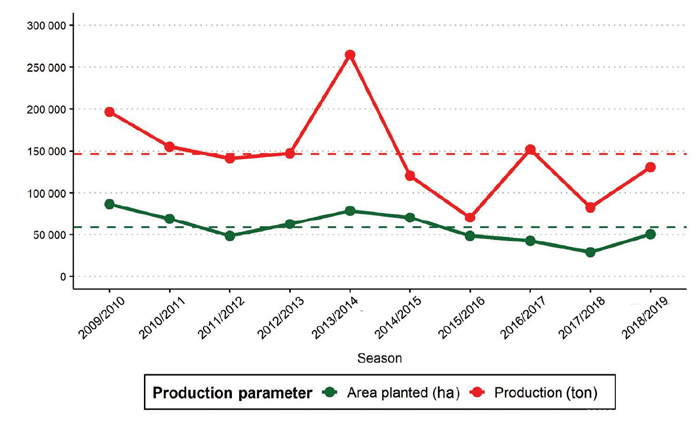
Source: Agbiz; DAFF; mean indicated by dashed line
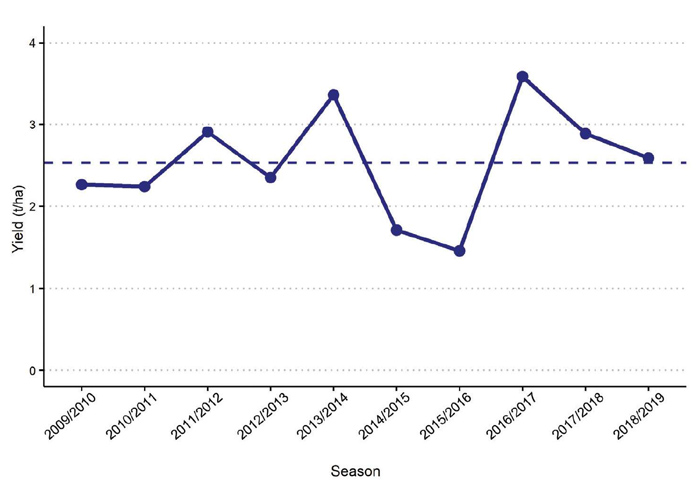
Source: Agbiz; DAFF; mean indicated by dashed line
Plant disease impact on yield
Disease tolerance and the effect of management practices, such as monoculture, are vital considerations in sorghum production. It is therefore important to know the diseases and their impact in an area and to select the relevant cultivars that have the best tolerance in that particular environment. Annual yield losses due to pests and pathogens can be as high as 30% internationally. Foliar diseases such as Exserohilum leaf blight, caused by Exserohilum turcicum (Photo 1) and anthracnose, caused by Colletotrichum graminicola (Photo 2) are a major concern for sorghum production in South Africa. These diseases cause yield reduction due to the loss of photosynthetic area. Sorghum head smut, caused by Sphacelotheca reiliana (Photo 3) is another disease of concern that has spread throughout some production areas in recent years due to the introduction of more susceptible sorghum germplasm into the local market.
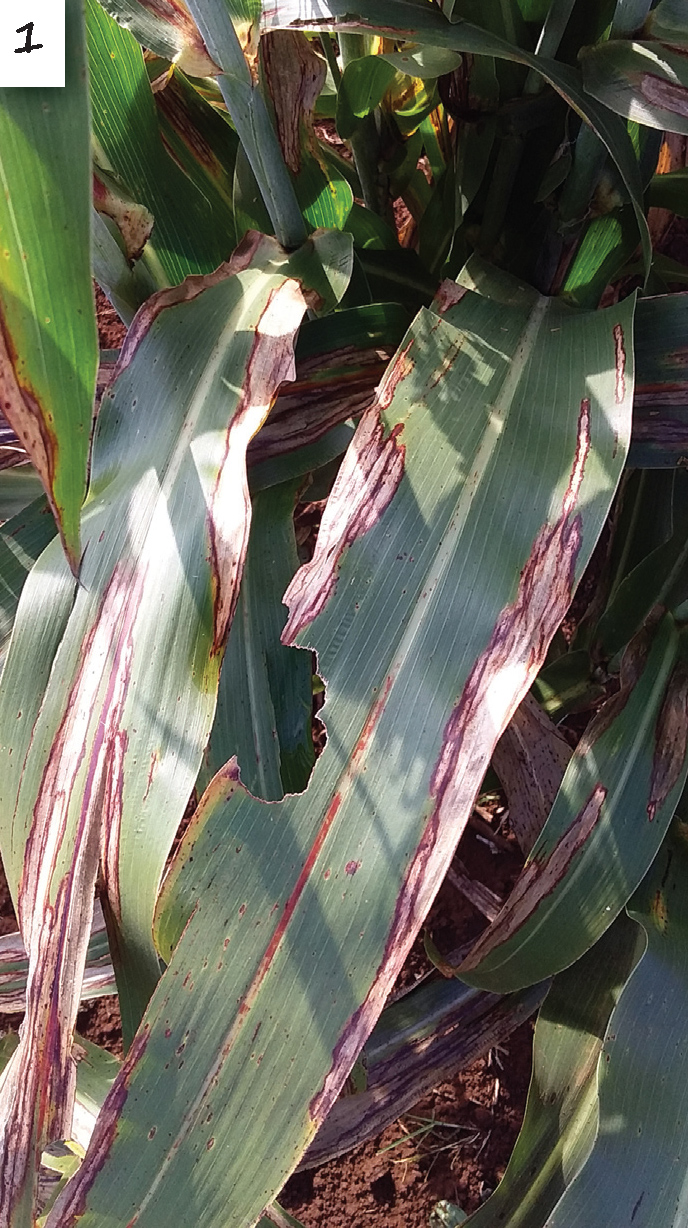
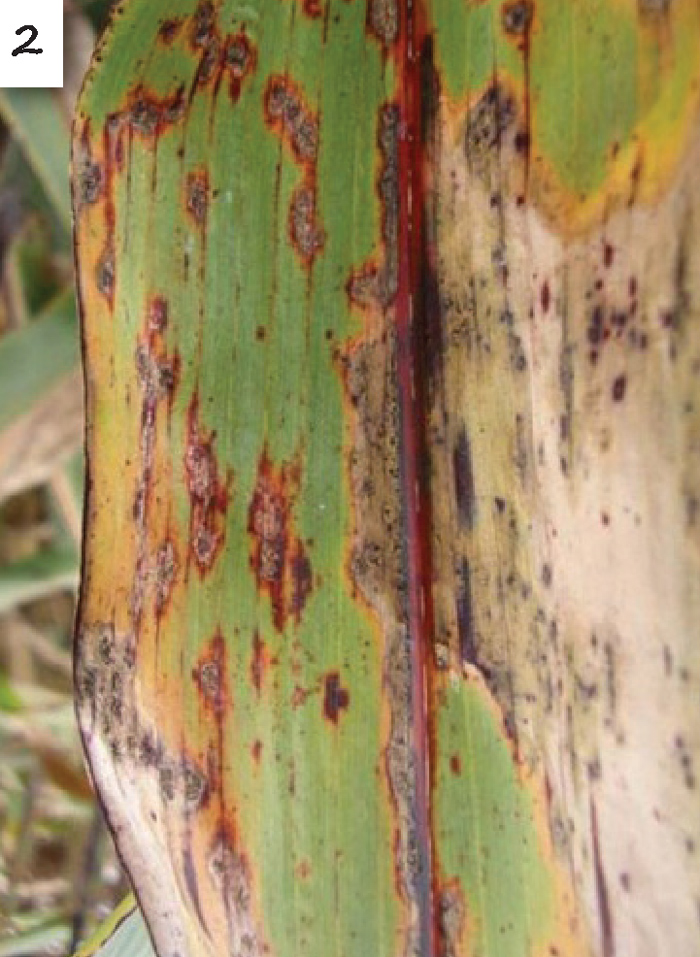
Source: NW McLaren
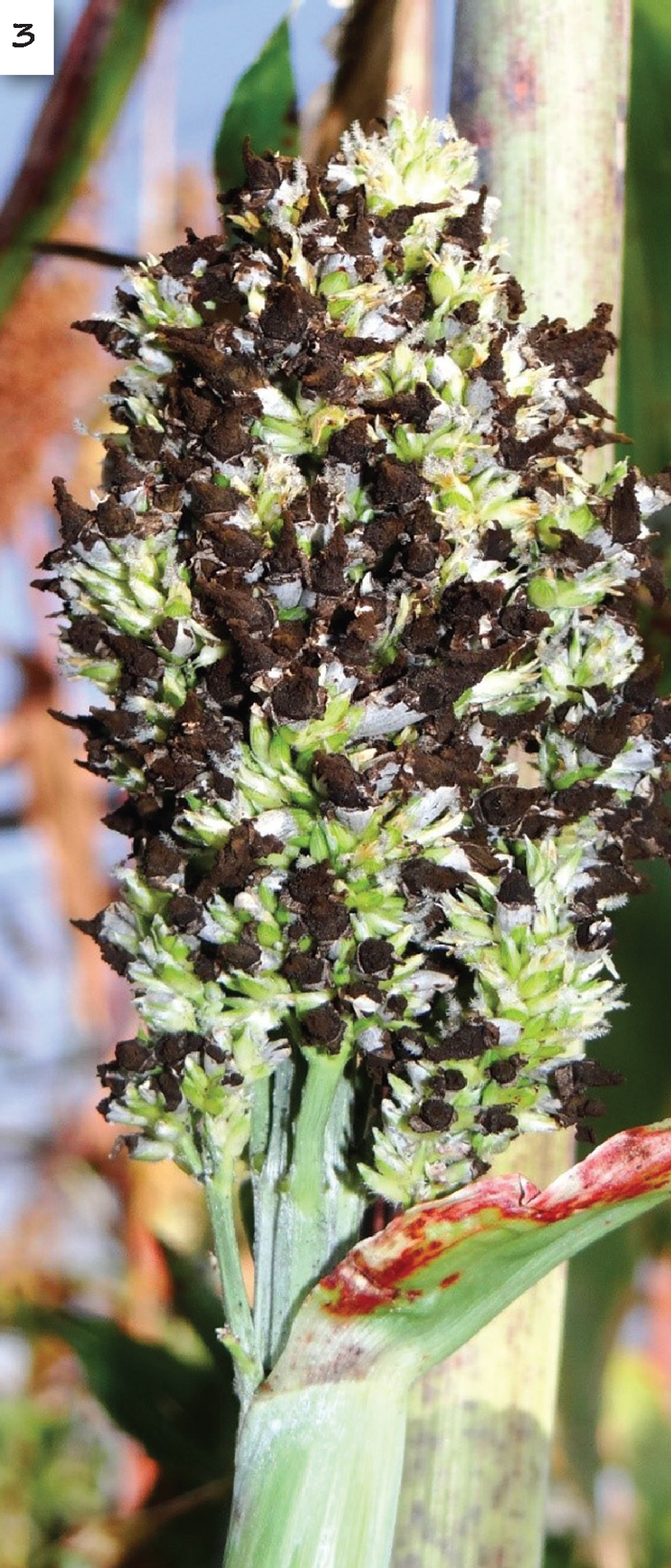
Source: NW McLaren
Grain mould (Photo 4) is caused by a complex of fungi, but damage is particularly observed through the colonisation of Fusarium thapsinum and Curvularia lunata. Together with sorghum ergot (Photo 5) caused by Claviceps africana, they are the principal constraints to sorghum grain quality in areas where moist conditions occur later in the growing season. Management practices such as the application of fungicides at the appropriate time can be highly effective at reducing the incidence of these fungal diseases.
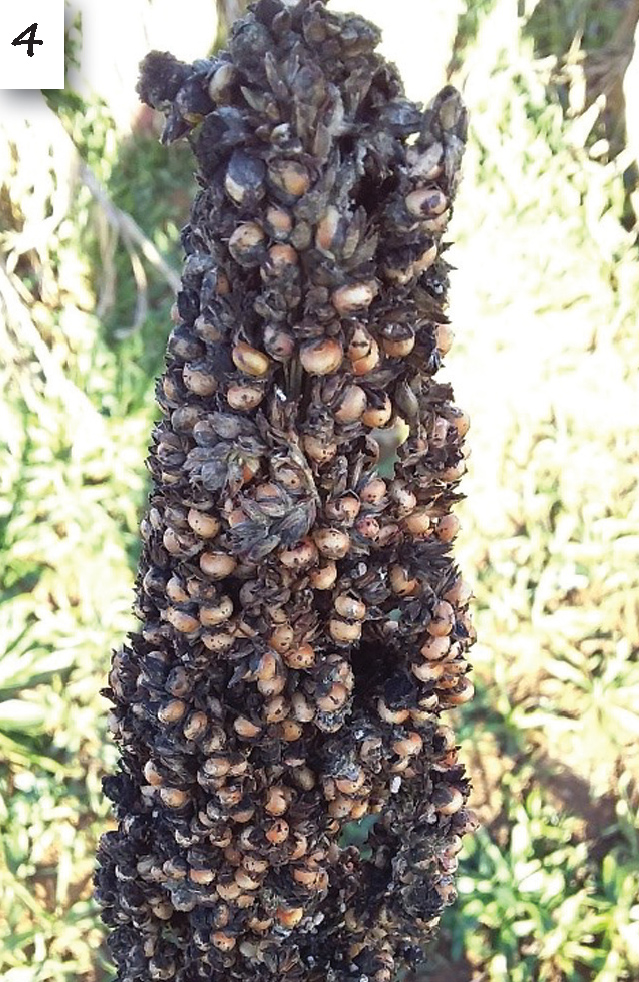
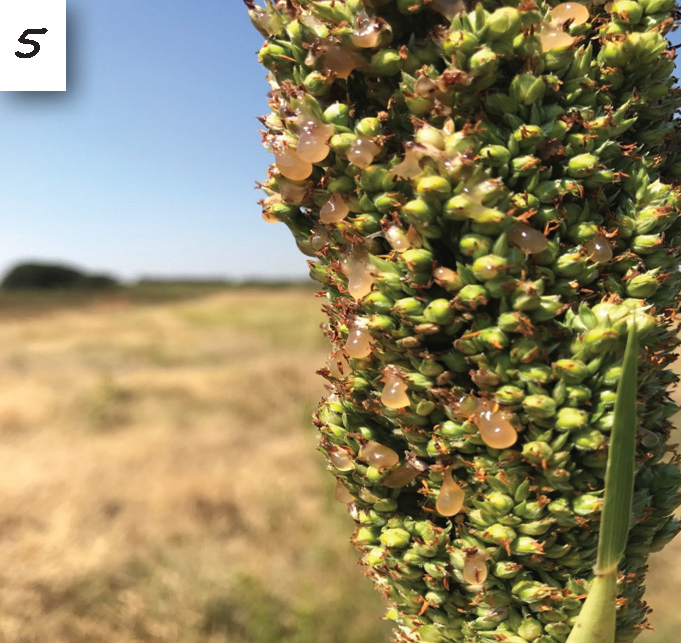
The University of the Free State (UFS) is currently conducting research on the potential to identify weather variables that are associated with higher risk of foliar diseases, working towards developing a decision support system for producers in managing leaf diseases.
It is very important to screen cultivars for adaptation to different environments. This enables producers to make informed decisions as to which cultivar to plant in which area. To this end, the ARC-Grain Crops and the plant pathology division of the Plant Sciences Department at UFS are collaborating on cultivar adaptation trials in Potchefstroom and Cedara.
ARC/UFS cultivar evaluation trials
Grain yield for twelve sorghum cultivars was determined during the 2019/2020 growing season at Cedara and Potchefstroom (Graph 3). PAN 8945, PAN 8816, PAN 8625, PAN 8944, PAN 8706, NS5511, Bullet, Avenger, Enforcer, Titan, Mr Buster and Swift were the cultivars screened. The trials were planted in mid-November 2019, harvested at physiological maturity and the yield was determined in tons per hectare in May 2020. Yield was determined without fungicide application, since leaf disease incidence did not exceed the 3% threshold for fungicide application. This season, as for many producers worldwide, was one with challenges – particularly the COVID-19 pandemic. However, the ARC-Grain Crops managed to ensure the harvest of trials for continuation of this research that is critical to our understanding of sorghum production constraints in South Africa.
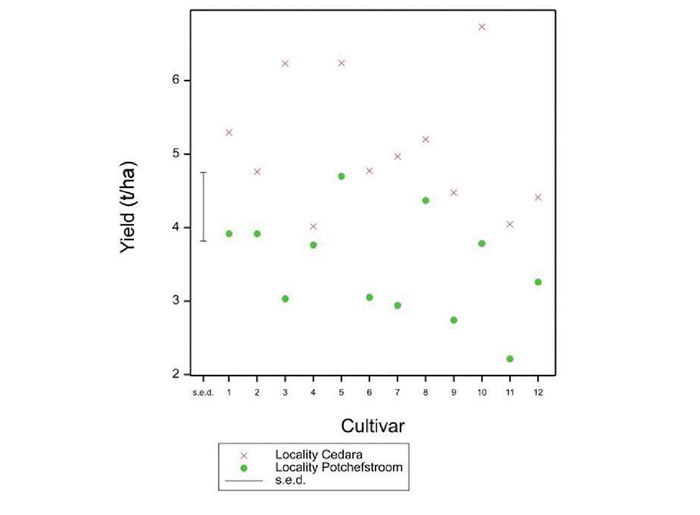
Cultivars: 1 = PAN 8945, 2 = PAN 8816, 3 = PAN 8625, 4 = PAN 8944, 5 = NS 5511, 6 = Bullet, 7 = Avenger, 8 = Enforcer, 9 = PAN 8706, 10 = Titan, 11 = Mr Buster, 12 = Swift
Conclusion
One of the most important annual management decisions a producer has to make is the choice of cultivar. Producers are inundated with information, marketing material and other media – making it increasingly difficult to decide and make sense of all the information. However, the ARC/UFS cultivar trials found that in Cedara, Titan was the highest yielding cultivar followed by NS5511, whereas PAN 8944 and Mr Buster were the lowest yielding cultivars. Mr Buster was also the lowest yielding cultivar in Potchefstroom, while NS5511 was the highest performer (Graph 3).
All cultivars performed well in Cedara when compared to Potchefstroom. This may possibly be due to differences associated with climatic environments of each region. According to the Köppen-Geiger climate classification, Cedara (near Pietermaritzburg) is classified as a dry-winter humid subtropical climate (Cwa) region, whereas Potchefstroom is a semi-arid (steppe) climate (BSk) region. This classification is based on temperature and rainfall associated with each region. The average annual temperature in a Cwa region is 18,2°C with an annual average precipitation of 897 mm, contrasting with a BSk region’s annual average temperature of 16,9°C and annual average precipitation of 615 mm. The higher rainfall at Cedara may contribute to greater yield potentials than those observed at Potchefstroom. However, there was no significant difference in yield between the two localities for PAN 8816, PAN 8944 and Enforcer (Graph 3), indicating that these three cultivars are adapted to both environments.
Please note that this information is presented in good faith and that the ARC and UFS do not accept any legal liability in terms thereof. As conditions may vary from farm to farm and even from land to land within each area, adjustments may be necessary based on local conditions. For further information contact Dr Edson Ncube and Desmond Nkoko at 018 299 6374 or ncubee@arc.agric.za or Lisa Rothmann at 051 401 3666 or coetzeela@ufs.ac.za.



















